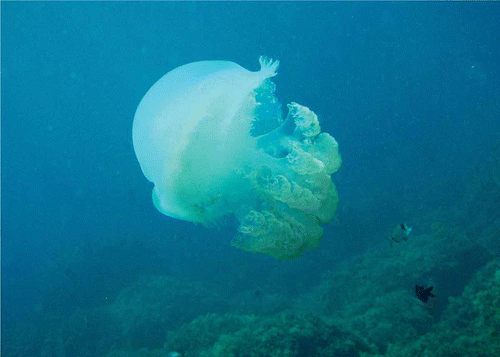New species are welcome, but … what about the old ones?
In spite of continuous claims that biodiversity is in great distress, zoologists continue to describe new species. Recently, the Italian Journal of Zoology published the descriptions of new protozoans (Moawad Citation2010), hydrozoans (Di Camillo et al. Citation2009), anthozoans (Bo et al. Citation2009), flatworms (Stocchino et al. Citation2009; Lanfranchi et al. Citation2010), oligochaetes (Dumnicka Citation2010), and insects (Scali Citation2009; Scali and Milani Citation2009; Audisio et al. Citation2010). Other papers recorded several new species for the Italian or even the Mediterranean fauna. It is so easy to find new species that I take advantage of this editorial to report about a scyphozoan jellyfish never previously recorded from the Mediterranean Sea. The species is Catostylus tagi (Haeckel, 1869) () and it was photographed by Maria Ghelia from the Island of Pantelleria on 27 June Citation2010. C. tagi is common in Portuguese waters and it evidently entered the Mediterranean Sea from the Gibraltar Strait, being transported to Pantelleria by the Gibraltar current. These accounts suggest that our biodiversity is steadily increasing and that more and more species are being added to the current checklists (now we have one more scyphozoan), inflating them at a fast pace. These additions contrast with the concept of biodiversity erosion and might induce some optimism regarding the state of our fauna. There is another side to the coin, however, regarding all these exciting new findings. What about the species listed as being present in a given geographical area? They are in the checklists, so they are supposed to be present, but are they? We are very attracted by positive data: we found this new species! However, we seldom, if ever, make the list of all the species that we should find and that are not found anymore. Negative records are not so exciting, unless the absentees are charismatic, such as some vertebrate or commercial invertebrate. Monk seals are gone, and we are very worried about them, but how many inconspicuous species are probably gone in complete indifference? I cannot name an extinct marine species from the Mediterranean Sea. New records for the Mediterranean are in the hundreds (and are often labelled as noxious aliens), whereas extinctions are unproven. The building of such lists started from the time of Linnaeus and continues to grow. Maybe it is time to check if all these species are still being found, and make lists of the ‘missing ones’. The task is very simple: what is the last published record of every species that is present in a regional checklist? Then one might ask: how many years of missing records are enough to build up a case of putative extinction? I am sure that red lists would be very large if we were using these criteria and I ask our readers (and authors) to start pondering these problems.
Ferdinando Boero
Editor-in-Chief
References
- Audisio , P , Trizzino , M , De Biase , A , Rossetti , G , Mancini , E and Antonini , G . 2010 . Molecular and morphological evidence of a new sibling species of Calobius (Coleoptera: Hydraenidae) of the C. quadricollis complex from peninsular Italy . Italian Journal of Zoology , 77 : 29 – 37 .
- Bo , M , Barucca , M , Biscotti , MA , Canapa , A , Lapian , HFN , Olmo , E and Bavestrello , G . 2009 . Description of Pseudocirrhipathes (Cnidaria: Anthozoa: Hexacorallia: Antipathidae), a new genus of whip black corals from the Indo-Pacific . Italian Journal of Zoology , 76 : 392 – 402 .
- Di Camillo , CG , Puce , S and Bavestrello , G . 2009 . Macrorhynchia species (Cnidaria: Hydrozoa) from the Bunaken Marine Park (North Sulawesi, Indonesia) with a description of two new species . Italian Journal of Zoology , 76 : 208 – 228 .
- Dumnicka , E . 2010 . Two new freshwater enchytraeid species (Oligochaeta) from the Italian Alps . Italian Journal of Zoology , 77 : 38 – 43 .
- Lanfranchi , A , Melai , M and Meini , G . 2010 . Postbursoplana parafibulata sp nov.: A new flatworm from the Ligurian Sea (Platyhelminthes, Rhabditophora, Otoplanidae) . Italian Journal of Zoology , 77 : 168 – 171 .
- Moawad , TIS . 2010 . Flectacineta (Ciliophora: Suctoria) from Egypt: New records and new species . Italian Journal of Zoology , 77 : 149 – 158 .
- Scali , V . 2009 . Revision of the Iberian stick insect genus Leptynia Pantel and description of the new genus Pijnackeria . Italian Journal of Zoology , 76 : 381 – 391 .
- Scali , V and Milani , L . 2009 . New Clonopsis stick insects from Morocco: The amphigonic C. felicitatis sp.n., the parthenogenetic C. soumiae sp.n., and two androgenetic taxa . Italian Journal of Zoology , 76 : 291 – 305 .
- Stocchino , GA , Manconi , R , Corso , G , Sluys , R , Casu , S and Pala , M . 2009 . African planarians: Morphology and karyology of Dugesia maghrebiana sp. n. (Platyhelminthes, Tricladida) from Tunisia . Italian Journal of Zoology , 76 : 83 – 91 .
